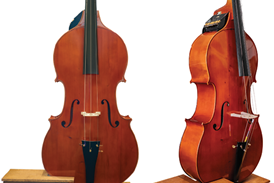Paul Hindemith did more than any other composer of his era to champion the viola as a solo instrument. Fifty years after his death, the American violist Kim Kashkashian reflects on the rewards and challenges of his music
I was around twelve years old when I first encountered the op.25 no.1 solo sonata. I used the third movement as an outlet to express and relieve some deep sadness in my life. I had experienced a death in the family, and the music helped. Hindemith’s musical language was something I felt very close to. The melodic, rhythmic, harmonic and kinetic energy made immediate sense to me. And in the years when I was growing up I felt musically freer playing Hindemith than with almost any other composer.
The viola sonatas span most of Hindemith’s musical development, and the stylistic changes that came with it. For students, it’s good to start with one of the op.11 solo sonatas, then op.31 no.4, before exploring the big cathedral of the 1939 Sonata for viola and piano. As for the concertos, many young players learn Trauermusik early on, because of its relative simplicity and accessibility, but more often than not Der Schwanendreher is learnt too soon, and should be saved for later. The Kammermusik no.5, however, isn’t learnt often or soon enough. It’s long, thorny and complex, but in some ways less problematic than Der Schwanendreher, and students can benefit a lot from learning it. Young players need to discover Hindemith’s harmonic language,
his musical structures, the melodic tensions and releases, and the strong emotional characters of his music.
I also get students to look at his paintings and letters. His paintings and drawings can be very whimsical, and they show a lighter side of his character that is often not known about or ignored. For example, he painted the outside walls of his house in Blonay, Switzerland, with some beautiful caricatures. The received image of the crusty old composer who wrote music with a dry logic is more than tempered by this humour and lightness, which are obvious when one looks at his paintings and reads his letters.
The emotional landscape of Hindemith’s music is always a joy to enter into. He clearly used the viola works as a chance to consider his life condition, his environs and his philosophy. There are particular challenges for the performer, such as how to realise the extremely lengthy crescendos that appear time and again in the op.25 no.4 Sonata. Hindemith writes mezzo forte, and then 40 bars later there’s a forte, and around 40 bars after that there’s a fortissimo. You’ve already been playing at your peak for a long time, and you realise you still have to keep going! I like to think of it as a train that’s hard to get moving, but once it’s started it won’t stop.
Hindemith took much from Bach and from Debussy. The early works are clearly defined by his love of French music, and throughout his life he went back to pre-Classical forms, to Bach’s forms. For example, in the op.11 no.5 and the op.31 no.4 solo sonatas, both final movements of 22 variations are structured and proportioned exactly like the Chaconne from Bach’s D minor Partita for solo violin, which can hardly have been done by accident. I think it was his reverence for Bach that made him construct those movements that way.
All composers who have championed the merits and value of the viola as a solo voice deserve our gratitude, but Hindemith’s exploration of range, kinetic energies and emotional character was perhaps unique for his time. He can certainly be seen as a catalyst for a new attitude to the viola and for the materialisation of its new role as a solo instrument.
This interview is part of a longer article, 'Viola Visionary', published in The Strad, December 2013.
Subscribe to The Strad or download our digital edition as part of a 30-day free trial.






































No comments yet